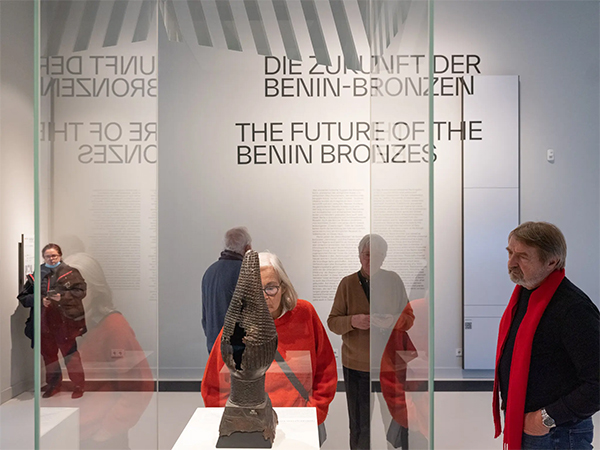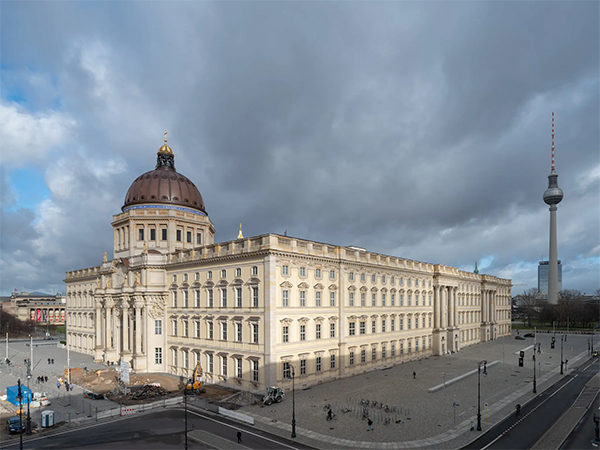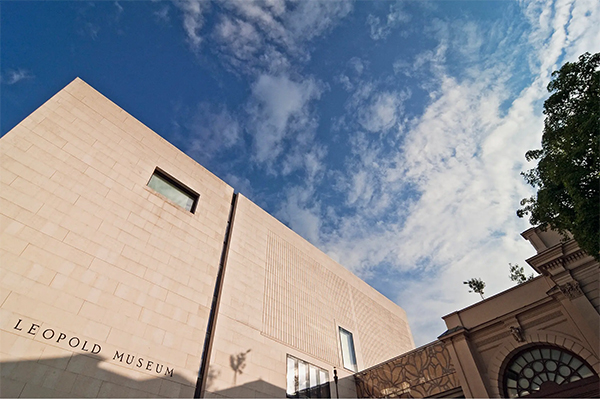A 16th-century Benin Bronze sculpture at the Humboldt Forum, a Berlin museum that has begun to repatriate some of the artifacts to Nigeria. The bronzes were taken from the Kingdom of Benin in 1897 by British forces. Credit…Andreas Meichsner for The New York Times.
Charly Wilder, When a Visit to the Museum Becomes an Ethical Dilemma, The New York Times, 14 February 2023
Western museums are major tourist attractions, drawing travellers from around the world. But what responsibility do we bear as spectators for patronizing institutions that display what critics say are stolen works?
To hear more audio stories from publications like The New York Times, download Audm for iPhone or Android.
On a recent morning, visitors trickled into the Africa wing of the Humboldt Forum in Berlin, a massive museum that opened in 2021 in a neo-Baroque reconstruction of the city’s former Royal Palace. The setup was familiar: Artifacts were enclosed behind glass and mounted onto white walls — an “ethnological display” of priceless artworks from a far-off land.
But this exhibition was different. Dozens of Benin Bronzes, intricate sculptures and plaques in metal that date back as far as the 13th century, were on display in Berlin for what may be the last time. Since July 2021, the artifacts no longer belong to Germany. They are part of a trove the country has begun to repatriate to Nigeria, beginning in December with the return of 20 bronzes. The exhibition tells not just the story of the objects, but also of their theft in 1897, when British forces sacked Benin City, looting the royal palace of the Kingdom of Benin in what is now southwest Nigeria.
Diagrams explain how the bronzes were acquired from European traders, while photos show British soldiers striking triumphant poses atop piles of loot. In one room, I joined tourists who watched videos depicting scholars, artists, German and Nigerian curators, and representatives of the royal family in Benin City discussing the significance of restitution.
Diagrams explain how the bronzes were acquired from European traders, while photos show British soldiers striking triumphant poses atop piles of loot. In one room, I joined tourists who watched videos depicting scholars, artists, German and Nigerian curators, and representatives of the royal family in Benin City discussing the significance of restitution.

The bronzes have been at the center of an international firestorm as calls mount for Western museums to take responsibility for how they obtained objects that were seized during the colonial era, or looted by Nazis and other invading forces.
For museumgoers, the ethical dimensions of viewing plundered art have become impossible to ignore. Western museums are major tourist attractions, drawing travelers from around the world. But what responsibility do we bear as spectators for patronizing institutions that display what critics say are stolen works? Should we be asking how these museums got their treasures? Does our conception of a modern-day ethnological museum need a dramatic rethink?
“There has been a great change of consciousness in the last years,” said Gilbert Lupfer of the German Lost Art Foundation, the world’s most extensive database for the search for Nazi-looted art. “More and more, visitors of museums have become interested in questions of provenance.” And most of them, he said, realize that works with a problematic provenance “can’t remain in the museum.”

A shift in perception, an increase in scrutiny
European and American museums have long resisted calls for repatriation, arguing that objects from Africa, Asia and elsewhere were legally obtained, that they are safer where they are, and that passing time and turmoil have made it impossible to determine rightful owners.
But in recent years, the scales have tipped.
“I think there’s been a big shift,” said Geoffrey Robertson, a British-Australian restitution expert and human rights lawyer, and the author of the 2020 book “Who Owns History?” “It started in a way with President Macron saying that Indigenous art, so much of which is in Western museums, should go back to Africa,” he said, referring to President Emmanuel Macron’s 2017 pledge to return France’s plundered African holdings.
In 2021, the German, Dutch and Belgian governments all announced plans to identify objects in museums that were looted during the colonial era and start the process of returning them. At least 16 U.S. museums have said they are engaged in the process of repatriating their Benin Bronzes, including the Smithsonian Institution and the Metropolitan Museum of Art in New York, and five more say they would be willing to do so if requested.
The increased scrutiny is not reserved for colonial plunder. Many institutions are reassessing their handling of artworks believed to have been stolen by the Nazis, who looted cultural property from every territory they occupied, targeting Jews in particular, and ultimately amassing hundreds of thousands of objects. Many of those objects ended up in auction houses and museums across the world. According to the United States National Archives, upward of 20 percent of all European art was looted by the Nazis.
Last year, New York State passed a law requiring museums to identify art stolen by the Nazis on placards “prominently placed” alongside the art. Last February, the decision of a committee in the Netherlands to return a Kandinsky to the family of a Jewish woman who most likely owned it before the Holocaust is the latest decision in that country favoring restitution.
And this year, the descendants of a German-Jewish collector filed suit against the Solomon R. Guggenheim Foundation for ownership of a Picasso masterpiece that the collector sold after fleeing Nazi Germany on the grounds that the sale was made under duress.
In Germany, over the last 10 to 12 years, Mr. Lupfer said that museum professionals have largely gone from fighting to retain contested holdings to “realizing that it’s absolutely necessary— it’s ethically, politically, socially necessary— to make restitutions.”

Which is not to say that all European museums came to that conclusion easily. The Leopold Museum in Vienna, which was formed from the private collection of Rudolf and Elisabeth Leopold, has long been shrouded in controversy regarding Nazi-looted art.
In 1998, the Manhattan district attorney served a subpoena to the Museum of Modern Art, ordering it to hold two Egon Schiele paintings on loan from the Leopold after a New York Times investigation uncovered their disputed ownership. Later, an independent 2008 study found that numerous artworks in the museum had belonged to people persecuted by the Nazis, and that Dr. Leopold, who died in 2010, had reason to suspect they had been looted.
After years of sparring in the courts, the museum reached settlements with the heirs of the original owners of 11 artworks, including one of the two seized in New York. Contested paintings are now displayed with labels explaining that they were taken from Jewish owners by the Nazis.
Hans-Peter Wipplinger, the director of the Leopold, emphasized in a statement that the museum has prioritized provenance research since its inception, and in 2003 commissioned an in-house researcher, whose work was complemented by the independent panel beginning in 2008.
“By the end of 2020, the independent provenance researchers had concluded their research into the core collection of the Leopold Museum,” Mr. Wipplinger said, noting that they “have been unable to identify further works from the Leopold Museum’s collection with a history of confiscation during the National Socialist era. Should such works be identified in the future, the Leopold Museum Private Foundation will seek and implement a ‘fair and just solution.’”
But critics say that provenance has still not been established for more than 90 percent of the artworks in the museum, which is a private collection and not beholden to Austria’s federal restitution guidelines.
Visitors, many of whom have travelled from afar to see the world’s largest collection of Schieles, have to reckon with the knowledge that the art they are viewing might have been stolen from Holocaust victims.

